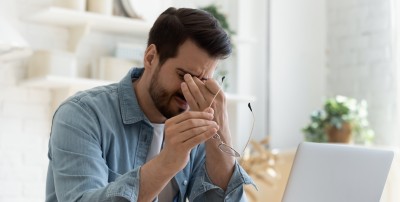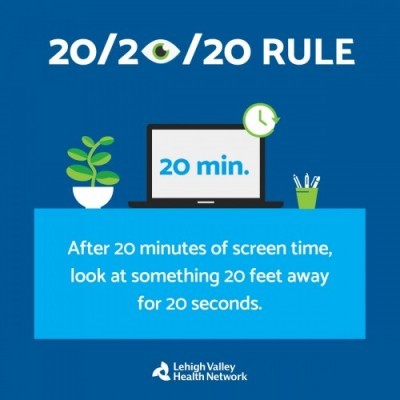
Did you know there are more than 150 types of headaches? While the source of many types of headaches is unknown, it’s clear that eye strain can leave you rubbing your temples. With many people working remotely during the COVID-19 pandemic, more people may be feeling eye strain than ever before.
What is eye strain?
“The main issue is overuse or extended visual activity,” says Christine Saad, MD, with LVPG Ophthalmology–Fogelsville. “Any extended visual activity can cause eye strain. It can easily happen when a person focuses on a computer or a phone for an extended period.”
You’ll know if your headache is caused by eye strain if you find relief from closing your eyes or discontinuing work. The first step to alleviating eye strain is to locate the cause.
-
Lighting – Incorrect lighting can exhaust your eyes. Soft lighting is best if you are looking at a computer. Harsh lighting can cause your computer screen to produce a glare which puts additional strain on your eyes. Lighting that’s too low also is a problem. If you are reading a book or papers, make sure your light source is pointed directly at your reading material. Worried that you won’t get the lighting just right? Don’t – you’re the best judge. “It’s whatever is comfortable for you,” Saad says. “What’s right for one person may not be for another.”
-
Computer settings – Make sure your screen is customized to your vision preferences. If text appears smaller than you like, adjust your display settings to give your eyes a break. Blue light has been shown to cause eye fatigue as well. You can adjust the amount of blue light your computer screen or mobile device emits or wear glasses that filter out blue light.
-
Incorrect prescription – It’s important to get an eye exam at least once a year. If there have been changes in your vision since your last eye exam, you may experience eye strain.
-
Dry eyes – Eye dryness and eye strain can have a snowball effect. “If you already have dry eyes, eye strain will exacerbate it,” Saad says. “Eye strain can also cause dry eye.” If you’re experiencing dry eye, try using artificial tears three to four times a day. If that doesn’t provide relief, call your eye doctor.
Listen to your eyes
If your eyes need a break, take one. Saad recommends the 20/20/20 rule: “After looking at a screen for 20 minutes, take a 20-second break and look at something that is 20 feet away.”
If you aren’t able to improve your eye strain on your own, schedule an eye exam appointment. To learn more about LVPG Ophthalmology and schedule an appointment, visit LVHN.org/ophthalmology.

